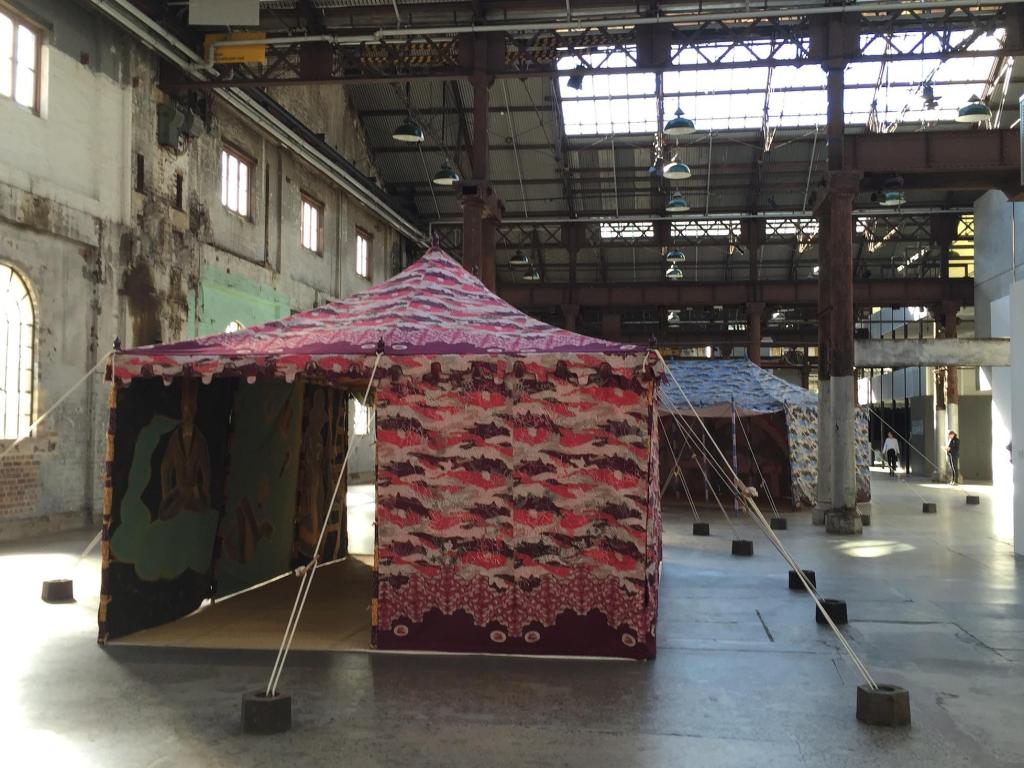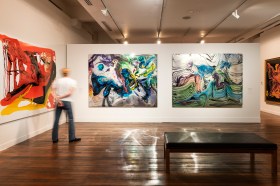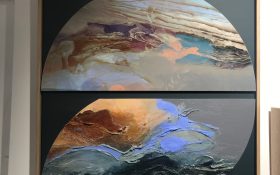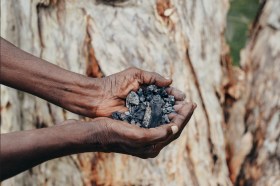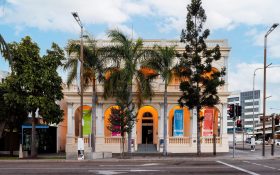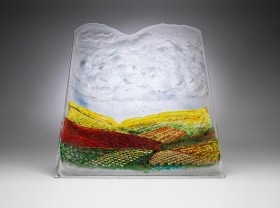Installation view Encampment at Carriageworks; Photo ArtsHub
Francesco Clemente’s work is held within the collections of our state and national galleries and yet, until now, his work has not been presented in a major exhibition in Australia.
Encampment is the second in the Schwartz Carriageworks series of international visual arts projects, and it ambitiously pushes beyond the white cube space to literally set up camp in the industrial foyers of the multi-arts space in Sydney.
Like any transformed industrial sites or biennale venues where the spectacular of the architecture seemingly vies rather than converses with the artwork, this project not only holds its own but sings.
Six large and elaborated hand-painted, hand-embroidered tents turn the 30,000 square feet Carriageworks into what curator Nina Miall described as ‘an opulent tented village’.
Clemente and two of his tent makers from Jaipur in Rajasthan, India, were in Sydney for the unveiling. The structures were the result of three years work, and simply they are exquisite for their sense of hand, enchantment and reach to audiences.
New spin on the tent city
Upon encountering Clemente’s tents, it is very much a conversation of collaboration and craftsmanship that you tap into; the references printed and painted on the surface of the tents blend Eastern and Western ideas and motifs into a new language that is distinctly the artist’s.
Their camouflaged print has been created using a traditional hand-wood block printing technique, which is overlaid with narrative designs embroidered with golden thread and taking their cue from miniature painting.They are luscious in their materiality and yet are not compromised in their political punch or rigor.
Detail of hand-embroidered tent, Taking Refuge (2012-2014); Photo ArtsHub
The interiors are painted in tempera by Clemente and in contrast are more painterly and allegorical than the emblematic exteriors. Their washy narrative evokes a sense of nostalgic and fading memories, or perhaps it is just the illusive haze of the exotic – something imagined and distant in all that heat and dust.
The sense of hand breathes life into these structures, which have a gentle aroma of another place.
Interior detail of tent painted by Clemente; Photo ArtsHub
You can’t help but feel an element of mysticism encountering them – whatever that might mean within your own personal vocabulary – as their stories probe both the real and the metaphysical.
Each tent has been themed.
The Pepper Tent is about the spice trade that opened up India. Clemente said: ‘Pepper and spices connected India to the world and without pepper we would have never heard of yoga.’
He says of his Angels Tent: ‘Today’s angels are very tired. Indifference wears one out more than hate’, while Clement reminds us of Swedenborg’s philosophy that Heaven and Hell are perfectly balanced in his Devil’s Tent. ‘Beauty is nothing but the beginning of terror.’
Clemente represents the vernacular of the tent from its carnivalesq whimsy of childhood outings to the kind of political overtones of contemporary society – such as tent cities of refugees, the Aboriginal Tent Embassy, the Occupy Moment and the structures of war.
But this exhibition doesn’t feel heavy handed. Quite the contrary; it charms us into contemplation.
‘I am not afraid of narrative; I am not afraid of meaning and I am not afraid to compare painting to experience,’ said Clemente emphatically.
The experience of these tents is intended to be a slow unfolding where the passer-by is first drawn in by the colourful structures and then sucked into their belly of secrets.
installation view suite of drawings by Francesco Clemente; Photo ArtsHub
East-West blur
The exhibition is expanded with a suite of 19 erotically-charged watercolours from the series, No Mud, No Lotus (2013-2014), named after the contemporary Buddhist text on the transformative nature of suffering.
Miall explained that Clemente: ‘Repeatedly looked to Eastern philosophy and spirituality as a way of escaping Western materialism’.
Oscillating between the figurative and abstraction, these drawings seemingly prickle with erotic pleasure, and yet are edged with a darker sensibility – slightly unsettling – that leaves one questioning.
As with the tents, the watercolours create a hybrid language.
We need to be unsettled more often, but without the kind of wallop that so much contemporary art dishes out, too caught in its own politics and message. Clemente offers a calm without compromise.
Alongside the tents and drawings, and anchoring the installation like an icon on an altar, are four sculptures that hover on hand-crafted pedestals. Titled Earth, Moon, Sun and Hunger, they call on both the everyday and the elemental corners of life.
Installation view of sculptures as part of Encampment exhibition at Carriageworks; Photo ArtsHub
For me these were the least gut-grabbing; the kind of structural / sculptural shift between the tents and the frame like presentation of the objects was too much of a jar. They did however, extend the drawings beautifully.
Walking away from Encampment one feels a strange sense of renewal. Is it faith in the story, is it faith in the work? There is something lingering in Clemente’s work that is beyond logical description.
He explains: ‘Every single moment of the unfolding experience of the work is just a pretext to move on, to move forward from that moment. It’s never supposed to be a beginning of an ending; it’s supposed to be a transition.’
The Italian artist came to prominence in the mid-1970s and for the past three decades has divided his time between Varanasi, India, and New York, USA.
‘(In India) I found a place that was utterly contemporary and with the same vitality and drive that I knew of in the West, but in completely alternative terms’, he said.
This nomadic sensibility lies at the heart of Francesco Clemente: Encampment, reflecting the vibrancy of his surroundings and synthesising wildly different influences.
It is a journey clearly obvious in the work, and a journey that he invites others to share.
Rating: 5 out of 5
Francesco Clemente: Encampment
Carriageworks, Everleigh, Sydney
30 July – 9 October
